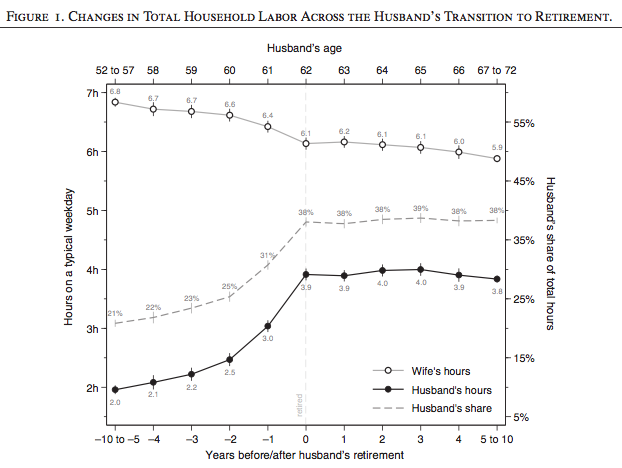Highlights
Most of us dream of spending our retirement traveling, relaxing with friends and family, volunteering, and devoting more time to hobbies and crafts. Time diaries suggest the reality of retirement is a bit more mundane: retirees do spend a bit more time socializing, volunteering, and exercising than their working peers, but larger time gaps show up for watching TV and sleeping than for those activities. And according to a new study of German couples, men, in particular, do more household work in retirement—enough to significantly narrow the gender gap in the domestic sphere.
Researchers Thomas Leopold and Jan Skopek used data from 28 waves (1985-2012) of the German Socio-Economic Panel Study to investigate how couples reallocated their household labor as the male breadwinner approached and entered retirement. Their sample included a total of 1,302 couples, with at least ten years of data on most of them. Each year, both partners reported how much time they spent on three types of household labor—"(a) routine housework (washing, cooking, cleaning), (b) errands (shopping, trips to government agencies, etc.), and (c) repairs (on and around the house, car repairs, garden work)"—on a typical weekday. Leopold and Skopek then used fixed effects regression models to study how the division of labor changed over time, controlling for wives' employment, both partners' health satisfaction, and several other variables.
You might expect couples to show little change in how they share chores in retirement: After all, household labor "becomes increasingly gendered over the initial years of marriage, especially after parenthood . . . [and] remains deeply gendered throughout working life," prior studies show, and old habits die hard. On the other hand, men gain a large amount of free time when they retire, so as Leopold and Skopek note, "even if wives remain the more competent homemakers, this shift in relative resources should [according to a rival hypothesis] instigate a process of adaptation, reconfiguration of previous roles, and reallocation of time."
Cross-sectional studies show support for both theories, but Leopold and Skopek's longer-term data very much fit the latter one. In their words, they found "a marked convergence of the gender gap across husbands' transitions to retirement":
In the reference period, spanning 10 to 5 years before the husband's retirement, average hours of household labor . . . were estimated at 6.8 hours among wives and 2.0 hours among husbands [per typical weekday]. Hence, the gender gap amounted to 4.8 hours in absolute terms and 21% in terms of the husband's share. Over the next years, this gap narrowed. As shown by the curves in Figure 1, convergence started slowly but gained momentum as couples approached the transition to retirement. In the year of the husband's retirement, this process was complete. Throughout postretirement years, the division of household labor remained almost unchanged, suggesting that a new equilibrium had emerged.
In the course of this convergence, the hourly gap narrowed to approximately 2.2 hours—a decline of more than 50% compared to the reference period. In relative terms, the husband' share increased by 17 percentage points (i.e., 80%), from 21% to 39% of a couple's total hours of household labor.

Men's increase in household labor was, on average, pretty evenly divided between routine housework, errands, and repairs/gardening. The time women spent on errands and repairs/gardening hardly budged, while the time they spent on routine housework declined by close to an hour. These changes dramatically narrowed the gender gap, but wives still performed two more hours of household labor per day than men, and 62 percent of it in all.
Do these findings apply to the contemporary United States? Although this study focused on couples in West Germany, a two-wave study of American couples published in 2000 obtained similar results. Given the major shifts over the past half-century in how men and women divide their responsibilities at home and in the market, however, we'd need a new and longer-term study to know for sure.














